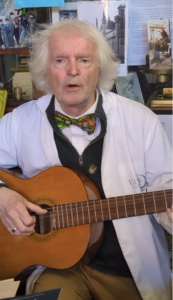Woody’s new novel “The Butterfly Tree” is available at Amazon (click here), other online retailers, and orderable at all bookshops.
*
More than a few memories did Bryan Brothers-like Chest Bumps inside my mind the other day when it was announced Mike and Bob have been voted into the International Tennis Hall of Fame, joining Maria Sharapova in the Class of 2025 next August in Newport, Rhode Island.
My earliest flashback was playing Monopoly on a rainy day at the Bryan family’s home in Camarillo. Wayne, the identical twins’ father and the teaching pro at nearby Cabrillo Racquet Club, had brought a handful of junior players, myself included, to his house since the courts were flooded.
Mike and Bob were in another room, napping in their shared crib, and were the reason the game was extra spirited: the stakes were that the Monopoly loser had to change their diapers when they woke up. Even then, as I recall, Mikeandbob—two names as one, singular—were in such perfect synchronization that two of us kids were actually needed at once for doody duty.
Mikeandbob were barely out of diapers when they won their first doubles title at age 6 (in the 10-and-under division) and proceeded to grow into a two-headed monster standing 12 feet, 6 inches tall, with four arms and four legs, that devoured the tennis world by winning 16 Grand Slam doubles championships and 119 overall titles, both all-time records by a mile, plus Olympic gold and bronze medals, and helped Team USA win the Davis Cup. Too, they were ranked No. 1 in the world for 438 weeks during 22 years on the ATP Tour.
When I texted Wayne to congratulate him and Kathy for officially being Hall-of-Fame parents, he responded with a surprising off-the-court Mikeandbob memory involving my son, Greg, who was maybe 12 at the time.
As Wayne recalled in his text: “After 13 years competing all over the country in the juniors, two years at Stanford, and 22 years all over the world in the pros, you have a moving van full of memorable days. But on my personal Top Ten List is the day you and Greggie came by and I said, ‘Hey, the Bros. are back in town from the 13-week clay court season in Europe with a humungous load of dirty clothes and I gotta go to the local Camarillo Coin Op Laundry and get it done.
“ ‘Okay,’ Greggie says. ‘Let’s go do it!’
“You and Greggie had no idea what you had volunteered for and funny how I remember this, but we did a world-record 13 washer loads and 13 dryer loads that day and it took some two and a half hours and well over $50 worth of coins.
“But Greggie had a smile on his face the whole time and we shared some laughs and he did a beautiful job and it was a day I’ll never forget just hanging with him.”
My son was smiling because Wayne made it so much FUN!—all capitals with exclamation mark—by turning it into a series of games: guessing which washers and dryers would finish first; seeing who could match sock pairs the quickest; who could fold tennis shirts the best.
That afternoon in the laundromat was, in essence, how Mikeandbob became Hall of Famers—Wayne and Kathy always made tennis FUN! for their twin sons. Mikeandbob never needed to be told to practice; rather, the battle was pulling them off the court.
“Ha. Ha,” Wayne concluded in his text. “If there is ever a movie made on the Bros. journey, that laundromat scene has gotta be in it!”
A spirited game of Monopoly scene has gotta be in it, too!
* * *
Essay copyrights Woody Woodburn
Woody’s new novel “The Butterfly Tree” is now available in paperback and eBook at Amazon (click here), other online bookstores, and is orderable at all bookshops.
*
Woody writes a weekly column for The Ventura County Star and can be contacted at WoodyWriter@gmail.com. Follow him on Twitter and Instagram at @woodywoodburn.











